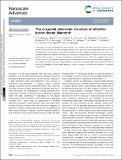Files in this item
The occupied electronic structure of ultrathin boron doped diamond
Item metadata
| dc.contributor.author | Pakpour-Tabrizi, A. C. | |
| dc.contributor.author | Schenk, A. K. | |
| dc.contributor.author | Holt, A. J. U. | |
| dc.contributor.author | Mahatha, S. K. | |
| dc.contributor.author | Arnold, F. | |
| dc.contributor.author | Bianchi, M. | |
| dc.contributor.author | Jackman, R. B. | |
| dc.contributor.author | Butler, J.E. | |
| dc.contributor.author | Vikharev, A. | |
| dc.contributor.author | Miwa, J. A. | |
| dc.contributor.author | Hofmann, Ph | |
| dc.contributor.author | Cooil, S. P. | |
| dc.contributor.author | Wells, J. W. | |
| dc.contributor.author | Mazzola, F. | |
| dc.date.accessioned | 2020-04-08T14:30:01Z | |
| dc.date.available | 2020-04-08T14:30:01Z | |
| dc.date.issued | 2020-03-01 | |
| dc.identifier | 267321972 | |
| dc.identifier | e3aec9ac-095a-411f-8497-0654f5b828e0 | |
| dc.identifier | 85082108832 | |
| dc.identifier | 000521420400041 | |
| dc.identifier.citation | Pakpour-Tabrizi , A C , Schenk , A K , Holt , A J U , Mahatha , S K , Arnold , F , Bianchi , M , Jackman , R B , Butler , J E , Vikharev , A , Miwa , J A , Hofmann , P , Cooil , S P , Wells , J W & Mazzola , F 2020 , ' The occupied electronic structure of ultrathin boron doped diamond ' , Nanoscale Advances , vol. 2 , no. 3 , pp. 1358–1364 . https://doi.org/10.1039/c9na00593e | en |
| dc.identifier.issn | 2516-0230 | |
| dc.identifier.other | ArXiv: http://arxiv.org/abs/1907.00673v1 | |
| dc.identifier.uri | https://hdl.handle.net/10023/19769 | |
| dc.description | Funding: RBJ acknowledges the UK's Engineering and Physical Sciences Research Council (EPSRC) for partial funding for this activity (EP/H020055/1) as well as The EC's Horizon 2020 Programme for support from the “GREENDIAMOND” project (ID: 640947). This work was supported by the Research Council of Norway through its Centres of Excellence funding scheme, Project No. 262633, “QuSpin”, and through the Fripro program, Project No. 250985 “FunTopoMat” and 262339 “NEAT”. This work was supported by the Danish Council for Independent Research, Natural Sciences under the Sapere Aude program (Grants No. DFF-4002-00029 and DFF-6108-00409) and by VILLUM FONDEN via the Centre of Excellence for Dirac Materials (Grant No. 11744) and the Aarhus University Research Foundation. | en |
| dc.description.abstract | Using angle-resolved photoelectron spectroscopy, we compare the electronic band structure of an ultrathin (1.8 nm) δ-layer of boron-doped diamond with a bulk-like boron doped diamond film (3 μm). Surprisingly, the measurements indicate that except for a small change in the effective mass, there is no significant difference between the electronic structure of these samples, irrespective of their physical dimensionality, except for a small modification of the effective mass. While this suggests that, at the current time, it is not possible to fabricate boron-doped diamond structures with quantum properties, it also means that nanoscale boron doped diamond structures can be fabricated which retain the classical electronic properties of bulk-doped diamond, without a need to consider the influence of quantum confinement. | |
| dc.format.extent | 7 | |
| dc.format.extent | 2182426 | |
| dc.language.iso | eng | |
| dc.relation.ispartof | Nanoscale Advances | en |
| dc.subject | QC Physics | en |
| dc.subject | QD Chemistry | en |
| dc.subject | NDAS | en |
| dc.subject.lcc | QC | en |
| dc.subject.lcc | QD | en |
| dc.title | The occupied electronic structure of ultrathin boron doped diamond | en |
| dc.type | Journal article | en |
| dc.contributor.institution | University of St Andrews. School of Physics and Astronomy | en |
| dc.contributor.institution | University of St Andrews. Centre for Designer Quantum Materials | en |
| dc.identifier.doi | https://doi.org/10.1039/c9na00593e | |
| dc.description.status | Peer reviewed | en |
| dc.identifier.url | http://www.rsc.org/suppdata/c9/na/c9na00593e/c9na00593e1.pdf | en |
This item appears in the following Collection(s)
Items in the St Andrews Research Repository are protected by copyright, with all rights reserved, unless otherwise indicated.

